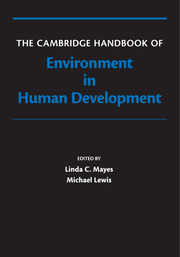Book contents
- The Cambridge Handbook of Environment in Human Development
- The Cambridge Handbook of Environment in Human Development
- Copyright page
- Contents
- Notes on Contributors
- The Role of Environments in Development:
- Part I The “Environmental” Variable
- Chapter 1 Proximal to Distal Environments in Child Development
- Chapter 2 Risk and Adversity in Developmental Psychopathology
- Chapter 3 Maternal Care as the Central Environmental Variable
- Chapter 4 Novel Assessment Techniques Aimed at Identifying Proximal and Distal Environmental Risk Factors for Children and Adolescents
- Part II Contemporary Themes
- Part III Environments
- Part IV Measurement
- Index
Chapter 1 - Proximal to Distal Environments in Child Development
Theoretical, Structural, Methodological, and Empirical Considerations
from Part I - The “Environmental” Variable
Published online by Cambridge University Press: 05 October 2012
- The Cambridge Handbook of Environment in Human Development
- The Cambridge Handbook of Environment in Human Development
- Copyright page
- Contents
- Notes on Contributors
- The Role of Environments in Development:
- Part I The “Environmental” Variable
- Chapter 1 Proximal to Distal Environments in Child Development
- Chapter 2 Risk and Adversity in Developmental Psychopathology
- Chapter 3 Maternal Care as the Central Environmental Variable
- Chapter 4 Novel Assessment Techniques Aimed at Identifying Proximal and Distal Environmental Risk Factors for Children and Adolescents
- Part II Contemporary Themes
- Part III Environments
- Part IV Measurement
- Index
Summary
Information
- Type
- Chapter
- Information
- Publisher: Cambridge University PressPrint publication year: 2012
Accessibility standard: Unknown
Why this information is here
This section outlines the accessibility features of this content - including support for screen readers, full keyboard navigation and high-contrast display options. This may not be relevant for you.Accessibility Information
- 4
- Cited by
